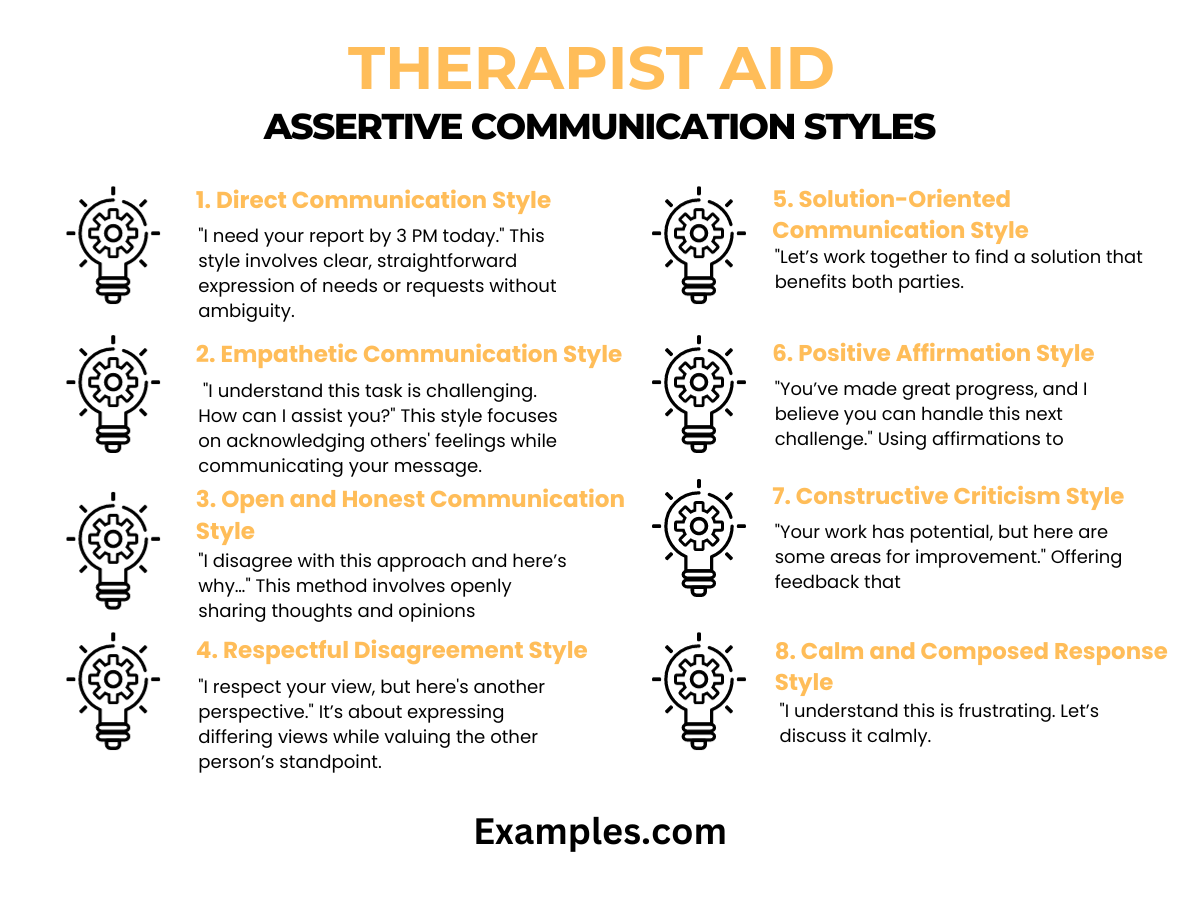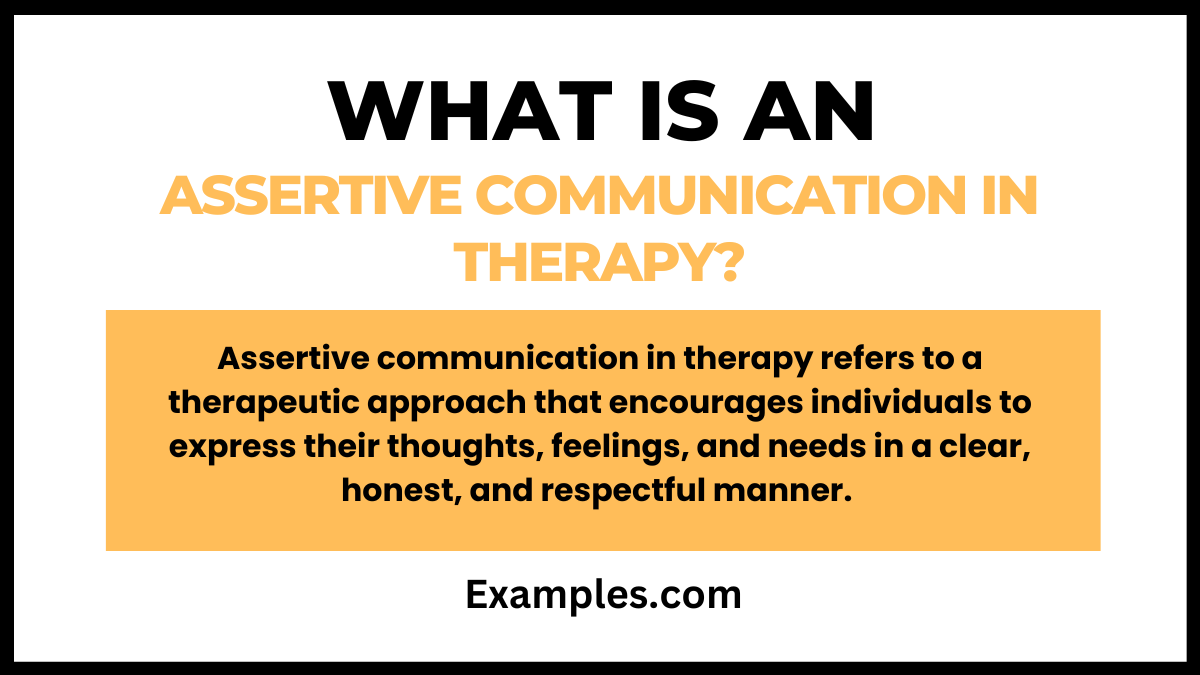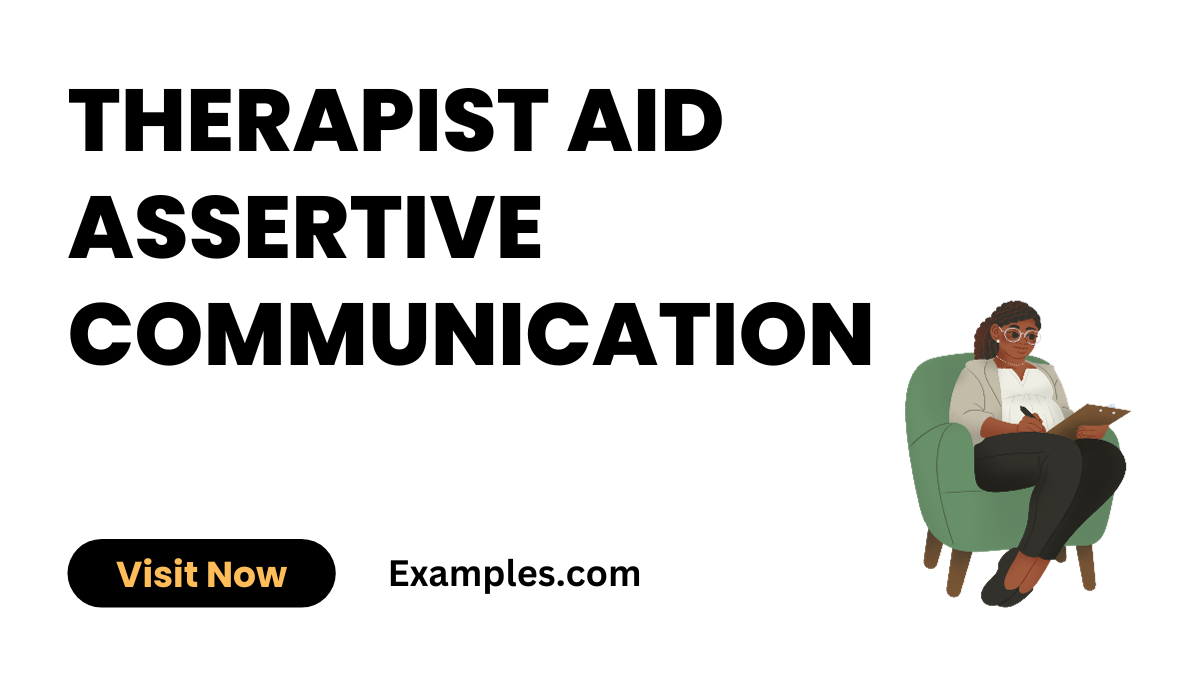19+ Therapist Aid Assertive Communication Examples
Welcome to the complete guide on Therapist Aid Assertive Communication, where we delve into the art and science of effective interpersonal exchanges. This guide offers a treasure trove of Assertive Communication Examples that illustrate how to convey your thoughts and feelings confidently, yet respectfully. Whether you’re looking to improve personal relationships or enhance professional interactions, these practical examples and insights will empower you to communicate more assertively and effectively in various life scenarios.
20 Examples of Therapist Aid Assertive Communication
Dive into the world of effective communication with our curated list of 20 Therapist Aid Assertive Communication examples. Each example is a testament to the power of assertiveness in enhancing interpersonal dynamics. From managing workplace interactions to nurturing personal relationships, these examples, complete with explanations, offer a practical blueprint for assertive communication. They are designed to guide you in expressing yourself clearly and respectfully, ensuring your message is heard and understood while maintaining positive connections.
- Requesting a Deadline Extension: “I understand the importance of this project, and I need additional time to ensure quality work. Could we discuss a feasible extension?” This approach shows respect for the project’s significance while clearly communicating your needs.
- Declining an Unreasonable Request: “While I appreciate your confidence in me, I’m currently at capacity with other commitments and won’t be able to take on this task.” This response respectfully sets boundaries and manages expectations.
- Expressing Disagreement in a Meeting: “I see your point, but I have a different perspective. Here’s what I think…” Offering a differing viewpoint respectfully, acknowledging the other’s opinion first.
- Giving Constructive Feedback to a Colleague: “I really value your creativity, but I think this approach might enhance our project’s effectiveness. What are your thoughts?” This example combines positive reinforcement with a suggestion for improvement.
- Addressing Unfair Treatment at Work: “I feel that I am not being given the same opportunities as others. Can we discuss this issue?” Speaking up about fairness issues calmly and directly.
- Asking for a Pay Raise: “I believe my contributions to the team have been substantial. I’d like to discuss the possibility of a salary adjustment.” Confidently and respectfully initiating a conversation about compensation.
- Setting Personal Boundaries: “I enjoy our conversations, but I need some quiet time during my lunch break to recharge.” Clearly stating your needs while maintaining a friendly tone.
- Handling a Conflict with a Friend: “I was hurt by what you said. Can we talk about it?” Opening up a dialogue about feelings without accusing or blaming.
- Negotiating a Compromise with Family: “I understand your point, but let’s find a middle ground that works for both of us.” Seeking a fair solution that respects both parties’ views.
- Resolving Customer Complaints: “I’m sorry you’re dissatisfied with our service. Let’s find a solution that makes you happy.” Acknowledging the issue and working towards a satisfactory resolution.
- Requesting Help from a Supervisor: “I’m struggling with this task and would appreciate your guidance or advice.” Directly asking for support while showing willingness to learn.
- Challenging a Bully in a Professional Setting: “Your comments are not constructive and affect the team’s morale. Let’s keep our communication professional.” Addressing bullying behavior firmly yet respectfully.
- Sharing Opinions in a Group Discussion: “I have a different view on this topic. May I share my thoughts?” Respectfully interjecting to offer a unique perspective.
- Asking for Clarification in a Misunderstanding: “I’m not sure I understand your point. Could you explain it a bit more?” Encouraging open communication to avoid confusion.
- Expressing Discomfort in a Relationship: “When you do this, I feel uncomfortable. Can we talk about it?” Directly addressing issues affecting your well-being in the relationship.
- Communicating Needs in a Team Project: “To achieve our goal, I think I need more resources. Can we discuss this?” Assertively stating what you need for successful project completion.
- Responding to Criticism Constructively: “I appreciate your feedback. I’ll consider these points to improve.” Acknowledging criticism positively and showing a willingness to grow.
- Declining an Invitation Politely: “Thank you for the invite, but I won’t be able to attend this time.” Expressing gratitude while clearly stating your unavailability.
- Proposing a New Idea at Work: “I have a suggestion that might benefit our project. Would you like to hear it?” Confidently introducing your ideas in a collaborative manner.
- Discussing Sensitive Issues with Sensitivity: “This topic is delicate, but it’s important we address it respectfully and openly.” Navigating sensitive subjects with tact and consideration for all involved.
Therapist Aid Assertive Communication Styles
Explore diverse Therapist Aid Assertive Communication Styles through our guide, offering insights into effective and respectful communication methods. This section illuminates how different styles can be adapted in various scenarios, enhancing your ability to express yourself assertively. From direct to empathetic styles, understand the nuances that make each method unique and effective in fostering constructive interactions and relationships.

- Direct Communication Style: “I need your report by 3 PM today.” This style involves clear, straightforward expression of needs or requests without ambiguity.
- Empathetic Communication Style: “I understand this task is challenging. How can I assist you?” This style focuses on acknowledging others’ feelings while communicating your message.
- Open and Honest Communication Style: “I disagree with this approach and here’s why…” This method involves openly sharing thoughts and opinions with honesty and transparency.
- Respectful Disagreement Style: “I respect your view, but here’s another perspective.” It’s about expressing differing views while valuing the other person’s standpoint.
- Solution-Oriented Communication Style: “Let’s work together to find a solution that benefits both parties.” This approach focuses on finding mutually beneficial outcomes.
- Positive Affirmation Style: “You’ve made great progress, and I believe you can handle this next challenge.” Using affirmations to encourage while communicating expectations.
- Constructive Criticism Style: “Your work has potential, but here are some areas for improvement.” Offering feedback that is both helpful and encouraging.
- Calm and Composed Response Style: “I understand this is frustrating. Let’s discuss it calmly.” Maintaining composure while addressing potentially heated topics.
- Non-Verbal Assertiveness Style: Maintaining eye contact and an open posture to convey confidence and attentiveness without words.
- Empathetic Listening Style: “I hear what you’re saying and understand it’s important to you.” Actively listening and showing understanding of the other person’s perspective.
Therapist Aid Passive Aggressive Assertive Communication
Delve into the intricacies of Therapist Aid Passive Aggressive Assertive Communication to distinguish between these contrasting approaches. This section helps you identify and understand the subtle differences and impacts of passive, aggressive, and assertive communication styles. Learn how to navigate these styles to improve your interpersonal communication skills, ensuring your message is conveyed in a respectful and effective manner.
- Passive Style in Assertive Communication: “Whatever you think is best.” Often involves yielding to others’ preferences to avoid conflict.
- Aggressive Style in Confrontation: “You better do it my way!” Characterized by dominance and forcefulness, often disregarding others’ feelings.
- Assertive but Respectful Disagreement: “I see your point, but I have a different view.” Balancing firmness with respect for the other person’s opinion.
- Passive-Aggressive Suggestion: “It’s fine, but I thought you cared about quality.” Indirectly expressing dissatisfaction or resentment.
- Firm Boundary Setting in Assertive Communication: “This is where I draw the line. Let’s respect each other’s limits.” Clearly defining personal boundaries with respect.
- Assertive and Empathetic Request: “I understand your situation, but I need this task completed by today.” Combining understanding with clear expectations.
- Passive Compliance with Inner Resentment: “I’ll do it, but it’s not fair.” Outwardly agreeing while internally disagreeing or feeling resentful.
- Aggressive Demand in a Meeting: “I want this changed now!” Imposing one’s will without considering others’ inputs or feelings.
- Balanced Assertive Persuasion: “Here’s my perspective. Let’s discuss what works best for everyone.” Encouraging open dialogue and fair consideration of all viewpoints.
- Subtle Passive-Aggressive Humor: “Nice of you to join us today, finally.” Using humor to mask criticism or displeasure.
What is Assertive Communication in Therapy?

Assertive communication in therapy refers to a therapeutic approach that encourages individuals to express their thoughts, feelings, and needs in a clear, honest, and respectful manner. This form of communication is key to building healthy relationships and self-esteem. It involves being open about one’s own needs while also considering the rights and feelings of others. In the therapeutic context, Assertive Communication is crucial for clients to understand and practice, as it can significantly improve their interactions both within and outside the therapy setting. This approach helps in reducing anxiety, resolving conflicts, and enhancing overall mental well-being. Therapists often emphasize the importance of assertive communication as a tool for personal empowerment and emotional regulation.
How do you Teach Assertive Communication in Therapy?
Teaching assertive communication in therapy involves several steps, each designed to enhance the client’s understanding and application of this vital skill:
- Understanding the Communication Spectrum: Therapy begins by helping clients understand the difference between passive, aggressive, and assertive communication. This is crucial for recognizing their own communication patterns.
- Role-Playing Scenarios: Therapists often use role-playing exercises to simulate real-life situations. This allows clients to practice Assertive Communication Scenarios, like expressing a difficult emotion or standing up for themselves.
- Using ‘I’ Statements: Teaching clients to use ‘I’ statements, such as “I feel” or “I need”, is a key aspect of Assertive Communication. This technique helps clients express themselves without blaming or attacking others.
- Active Listening Skills: Part of assertive communication involves listening actively. Therapists encourage clients to listen to others’ viewpoints with empathy and without judgment, enhancing mutual understanding.
- Body Language Awareness: Therapists work with clients to develop awareness of their body language. Non-verbal cues like eye contact, facial expressions, and posture play a significant role in Assertive Communication.
- Setting Boundaries: Clients are taught to set and respect personal boundaries, a crucial aspect of assertive communication. This helps in creating healthy relationships and self-respect.
- Feedback and Constructive Criticism: Clients learn to give and receive feedback in a constructive manner. This involves expressing thoughts and feelings openly and respectfully, even when the conversation is challenging.
- Building Self-Confidence: Therapy sessions focus on building self-confidence, as it’s essential for assertive communication. Clients are encouraged to value their own opinions and feelings, which is crucial in asserting themselves.
- Handling Conflict: Assertive communication is particularly important in conflict situations. Clients learn strategies for calm and effective communication during disagreements, aiming for resolutions that respect all parties involved.
- Regular Practice and Reflection: Finally, consistent practice and reflection are key. Therapists may provide Assertive Communication Worksheets or journals for clients to record and reflect on their daily communication experiences.
In conclusion, Therapist Aid Assertive Communication provides a comprehensive framework for enhancing communication skills in both personal and professional settings. The guide offers a plethora of Assertive Communication Examples and styles that cater to various scenarios, ensuring a well-rounded understanding and application of assertiveness??. These examples and styles demonstrate the effectiveness of assertive communication in respecting both self and others, leading to more harmonious and effective interactions.
The importance of assertiveness in therapy is further underscored by its potential to improve psychological well-being and relationships. Assertive communication in therapy encourages individuals to express their needs and feelings clearly and respectfully, fostering self-esteem, reducing anxiety, and resolving conflicts??. Techniques such as understanding the communication spectrum, role-playing, and setting realistic goals play a crucial role in teaching assertive communication in therapy, as highlighted in the guide??.
Additionally, assertiveness training has been linked to numerous benefits, such as reduced burnout, increased work commitment, and improved relationship satisfaction????. The guide from Positive Psychology further enhances this understanding by offering techniques for therapists and clients to develop assertiveness skills, emphasizing the importance of confidence, self-esteem, and being true to oneself??.
For those interested in exploring more about the benefits and techniques of assertive communication in therapy, the Mayo Clinic offers valuable insights into the advantages of being assertive and how it can help in stress management and self-empowerment. Their article “Being assertive: Reduce stress, communicate better” is an excellent resource for understanding the positive impact of assertiveness in various aspects of life (Mayo Clinic Article on Assertiveness)??.
Similarly, Positive Psychology provides a detailed overview of various techniques and attitudes that can be cultivated to improve assertiveness in therapy settings. Their article “How to Teach Assertiveness Skills in Therapy: 5 Techniques” presents practical methods and insights into developing assertiveness skills in therapy settings (Positive Psychology on Teaching Assertiveness)??.



